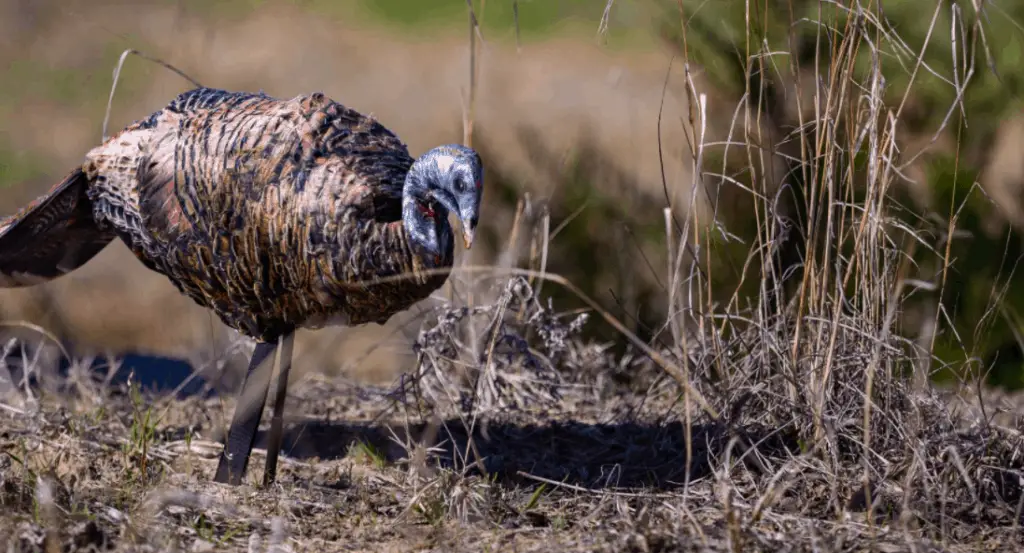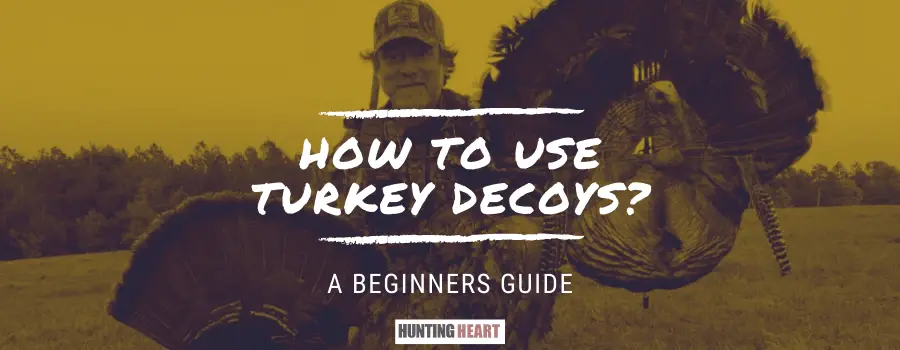As an Amazon Associate I earn from qualifying purchases.
Our Associate portal can be found here
Turkey hunting season is a time hunters look forward to every coming spring. Early preparations will ensure that you have a good start and that your hunting strategies are effective.
Using a turkey decoy is among the top ways to make your hunting successful. As spring season opens, turkey flocks are big, but the numbers soon shrink as the season progresses.
What this means is that you should change your hunting techniques as the season advances. For example, you can use multiple turkey decoys on the opening day and only a single decoy on the final week.
In between the first and final hunting week, you can have different turkey decoy setups.
Understanding the Types of Turkey Decoys and When to Use Them
Tom Decoys
When you want to catch the attention of a dominant and big turkey, a tom decoy is the best. It’s because tom decoy strikes an aggressive posture infuriating other toms. If they feel threatened, they come for a fight running to your kill zone.
Toms are best used during the mating season in spring.
Jake Decoys
Jake decoys are effective when used in both spring and fall. If it’s spring, a jake decoy deceives other Jake and toms that it’s breeding. The competition won’t allow your decoy to mate with the surrounding hens, and many will come rushing in the kill zone.
In fall, jakes and toms won’t allow the competition to feed in its territory. When they see your decoy feeding, they will rush into combat, and you can take your shot.
Hen Decoys
Hen decoys are versatile compared to the other two. You can make many adjustments and use them in almost any situation. For instance, in spring, adjust the hen decoy to a mating stance. The jakes and toms that want to breed with your decoy will come rushing into your kill zone.
If you have more hen decoys, the higher your chances of bagging a turkey.
Tips on How to Use Turkey Decoys
How to Setup a Turkey Decoy
Finding the perfect decoy setup determines if a tom or Jake will come strutting its feathers into your spread. Of course, oblivious that you are within a short gun range. Even though turkeys aren’t among the most intelligent animals, their survival instincts are high.
If you make your spread in a hurry, they can become wary and avoid coming closer. Your setup should therefore cover the following aspects.
1. Realism
Turkeys aren’t associated with mental capabilities. But it’s a mistake to think you can fool them with subpar decoys. Nothing short of a realistic turkey can fool these wild birds.
They are thorough to check if a decoy is fake or real. The first step of a setup is to use quality decoys.
2. Know the Turkeys
You can quickly tell apart the hens from the toms. However, Jake and hens may pass for each other. Therefore before choosing a decoy, differentiate between Jake and a hen. While turkey hunting is legal, in some places, you aren’t allowed to hunt hens.
One way of separating jakes from hens is checking the breast feathers. Jakes have black-tipped breast feathers, while hens have brown-tipped breast feathers.
Also, a hen’s legs are shorter than a Jake’s legs.
3. Timing
When setting up your decoy, timing your events ideally can be the difference between success and going home empty-handed.
Choose your decoy spread according to the time of season you are hunting. When spring starts, up until mid-May, the proper setup mimics Jake trying to court a hen. As fall approaches, jakes are no longer interested in one-on-one courtship.
Change your spread by bunching jakes and toms together in a feeding frenzy.
But the decoy setup that always works is the envious Tom or Jake. Here you position Jake to appear as if it’s over a compliant hen. However, this spread is primarily successful at the beginning of the turkey season.
Another effective spread is setting up a tom imposter surrounded by all hens. A mature tom can’t pass the opportunity to strut around an all-female spread.
4. Mimic Turkey Behavior
When turkeys are feeding in a field, it may appear as if they are wandering in a random, haphazard movement. In reality, turkeys generally feed following the same direction no matter how zigzag the formation appears.
When setting up your spread and using more than one decoy, face them in one direction.
Toms that see this spread will want to wander around the flock giving you enough time to pick your shot from a shotgun range.
5. Turkey Height
A common rookie mistake is using hens that tower over real toms. Keep balance and shape your spread.
A tom spends its life hovering over hens. If suddenly it wanders through your spread and all hens are towering over it, it will fly away.
6. Distance
People often wonder how far placed they should be from their decoy. It depends on the hunting gear you are using. If you are a bowhunter, setting the spread between seven to ten yards is ideal. You can double that distance if you are hunting turkey using a shotgun.
You can set the decoy closer so that you hunt toms that wander through the outside of your spread. Sometimes, the turkeys won’t commit, and you will have to take the shot regardless.
7. Observing Turkey Mood
Set your spread according to the turkey moods. At the beginning of spring, the turkey is in the mood for dominance. They fight over territory and society rankings. An aggressive decoy will bring some jakes and toms to your kill zone.
After some few weeks, the males are done with dominance, and their bodies are itching to breed. The smaller jakes might have emerged successful in some tough fights and can breed if they spot a fight they think they can win.
Set your spread using one Jake and a compliant hen. Mature toms will rush to break the pair while the Jakes might see some opening to score an easy fight.
At the end of the season, it’s time for nesting. The best decoy is a single hen, and turkey calls to get the toms in shotgun range fast.
How to Choose a Turkey Decoy Location
Choosing the location is essential because it determines the chances of success you will have. No hunter wants to leave empty-handed. Here is what you should do.
Look for an open field where both you and the turkeys can see the spread.
You want to be close but out of sight. An open area surrounded by a bush cover can provide the best spot.
Set up your decoy when the turkeys are not around. Even though turkeys are not super-intelligent, they rarely return to the same spot when they fly away.
Place your decoy downwind. Ensure that your scent is free from the kill zone.
When to Place a Turkey Decoy
You can hunt turkeys during the open season. If you prefer hunting at night or day, the outcome is still the same if you follow the hunting practices.
However, be careful when hunting hens as there can be restrictions, especially if it’s nesting season. When placing your decoy, consider how they pose. An aggressive tom or Jake during nesting can scare away other toms.
Three Best Turkey Decoys Review

1. Montana Miss purr-FECT
The market is now saturated with turkey decoys. They all claim to have impressive features. However, if you want the best lightweight decoy, it has to be miss purr—FECT. For an imposter turkey, it’s also lifelike and suitable for hunters who wish to travel light.
It’s a Montana decoy, and it features a 3D design and lifelike touch of real turkey colors to improve realism. The additional feather cuts are convincing and easily pass as a real turkey from a distance.
Montana miss purr—FECT embodies all the characteristics of a one-decoy-fits-all design. It means you can adjust the hen to portray different positions evoking desired results each time.
The head and neck movement can depict feeder, looker, or breeding poses.
Pros
- It’s lightweight
- It has adjustable body parts.
- Compact and collapsible to fit your vest pockets.
Cons
- It’s not as realistic as other models

2. Montana Purr—FECT Pair Decoy
The best news is that you can get these decoys as a pair or individually, depending on your hunting needs. It’s a good deal anytime you can get two for the price of one.
The Montana Purr—FECT pair comes as a durable yet easy-to-use decoy. At the site, you can stake them in your desired positions within minutes.
Because they come as a pair, you might assume they will be cumbersome to transport. On the contrary, they are compact and lightweight.
It features a collapsible model that you can deflate to fit your vest pocket. The realistic design of the duo decoy is classic. The feathers improve realism as they move when the wind blows at them. The Montana Miss purr—FECT pair will get toms and other gobblers running to the kill zone.
One way to achieve hunting success is by making it appear as if your imposter jake is pursuing the hen. Put the hen slightly ahead of the Jake, and other toms will come rushing in to prevent the imposter jake from breeding.
Pros
- Lightweight
- Portable
- Realistic and Lifelike
Cons
- It may take some time to inflate.

3. Montana Purr—FECT Jake Decoy
There aren’t many differences in features and adjustability from the Montana miss purr—FECT hen. The versatility, adjustable neck and head movements are impressive.
You can change poses to looker, feeder, and brawler with relative ease. The feather design makes the Montana purr—FECT jake is lifelike. The natural cuts offer realistic movements from the slightest wind contact.
Jakes is perfect for riling the anger in nearby toms. If you make it appear as if it’s trying to woo a hen, toms rush to the kill zone.
Pros
- Realistic and lifelike
- Lightweight
- Adjustable neck, head, and stakes
- Can deflate to fit your vest pocket
Cons
- The stakes aren’t tall enough.
Conclusion
Hunting using a turkey decoy brings the wild gobblers in your kill zone without so much hassle. Before buying a decoy, consider the features that make it lifelike. A lifeless decoy won’t attract the interest you seek and may instead spook your fowl.
A versatile turkey decoy is suitable for the entire turkey hunting season. The Montana Miss purr—FECT duo checks all boxes. You can tweak different poses and attract both hens, toms, and jakes to your kill zone.
Choose a durable decoy that can serve you for many hunting seasons without the need to replace it.
Amazon and the Amazon logo are trademarks of Amazon.com, Inc, or its affiliates.

36 years old, been hunting and fishing my entire life – love the outdoors, family, and all kinds of hunting and fishing! I have spent thousands of hours hunting hogs and training hunting dogs, but I’m always learning new stuff and really happy to be sharing them with you! hit me up with an email in the contact form if you have any questions.



